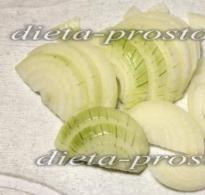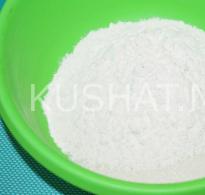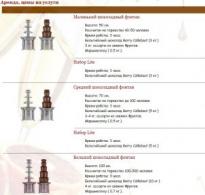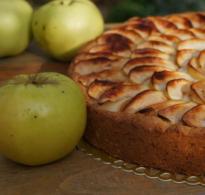What to add jam. How to thicken liquid jam into a pie filling
Many lovers of homemade preparations are faced with the problem of liquid jam. It happens that the housewives, seeing that the product is not as thick as planned, begin to “boil” it for 5-6 hours. However, in this way, only something will turn out that resembles burnt jam with the taste of burnt sugar. Why this happens, how to deal with this problem and make the jam thick, read the tips below.
What is the difference between jam, marmalade, confiture, jam
For ordinary people, these words seem to be synonymous, and, as they see it, they mean berries or fruits boiled with sugar (and sometimes with the addition of vegetables, citrus fruits, nuts, flower petals, honey). However, there is a difference between these terms.
- Jam is such a dessert, a type of preservation in which the fruits retain their shape. Thanks to this, the product has a characteristic texture.
- Jam is a product with a homogeneous consistency, prepared from fruit, berry or mixed puree.
- Jam or confiture (which, in fact, is the same thing) has a jelly-like structure. Often, for its preparation, the fruits are crushed or boiled to a homogeneous consistency with small inclusions of whole pieces or without them. For jams, thickeners are often used.
The easiest way to get a thick jam is to add pectin, agar-agar or gelatin to the mass. By the way, what is the difference between these substances, you can read.

- To obtain the consistency of confiture, 1 sachet of agar-agar is added to the product for 2 kg of fruit or berries. In this proportion, the jam will turn out moderately thick. If you need a marmalade structure, then add agar in the following ratio: 1 sachet per 1 kg of fruit.
- You can add pectin-containing products: grate apples, add currant puree or grated gooseberries, citrus zest. Experienced housewives know that redcurrant is a gelling berry.
- Harvest fruits only in dry weather. This advice is especially relevant for berries. The fact is that in the rainy season they become excessively saturated with moisture, “heavy”, and they need to be boiled for quite a long time. Most often, they make a rather unsightly jam: berries “float” in a very liquid syrup. If in your region precipitation fell within normal limits this summer, then there should be no problems with harvesting for the winter.
- If you wash the berries before making jam, then it is best to dry them, and only then start cooking. The fact is that after washing, a lot of droplets remain on the fruits, which in total significantly dilute the syrup. And for the jam to thicken, we don’t need extra moisture.
- Increasing the cooking time does not solve the problem at all. It is best to cook jam in three steps: this is how we save useful substances. Rather than keep the product on the stove for 3-4 hours, it is better to do this: cook for 15 minutes - remove from heat, cool for 6 hours (this is the minimum). So repeat 3 times.
- Don't forget to skim off the foam.
- Some types of jam are initially difficult to thicken in the usual ways. As an example, zucchini jam will be watery, since these vegetables themselves contain a lot of moisture.
- To thicken, some housewives advise adding lemon juice.
- The best cookware for cooking is a wide basin with low edges, as excess liquid in it evaporates better than in a saucepan. You can use any similar wide dish.
- How to thicken liquid cherry jam? If the syrup turned out to be more than expected, then pour into jars as much as you need, and add gooseberries to the remaining mass and boil. If you want to get the best result, pierce each berry with a toothpick (two holes are needed, that is, the stick should come out on the other side of the fruit). So the gooseberries will be filled with fragrant cherry syrup, and will not be shriveled.
If even after all these manipulations the jam turned out to be liquid, then some mistake was made. Do not be upset: serve it with pancakes, cheesecakes, make jelly out of it.
How to thicken jam for filling pies, layers of cake, pie and other pastries?
If you need a delicious filling for pies, layering a cake or any other pastry, and you only have liquid jam available, do not rush to get upset. We recommend using the following proven method.
Take the jam that needs to be thickened, pour it into a saucepan or into a metal ladle. Add semolina at the rate of: 1 teaspoon per glass of product. After that, mix the ingredients and leave for 10-20 minutes (this time is needed for the semolina to swell). Next, put the saucepan on a slow fire, boil for a couple of minutes.
Believe me, with this method of thickening the jam, semolina will not be felt at all! It will acquire the taste of boiled fruits or berries.
By the way, one more piece of advice. Usually, not the best jam is used for baking (as a rule, one that was underestimated by the household). Add a couple of tablespoons of lemon zest to the filling and you will see how much the taste changes.

Thick jams have a very pleasant taste and dense texture. How to thicken plum jam when cooking plum, what should be added to the pan with the main ingredients? How to thicken jam when cooking from plums so that the taste of the finished product is not affected? Experienced housewives know that it is the thick delicacy that adults and children love so much. If you want to make a truly delicious jam, you need to cook it using gelatin. It is better to choose a regular gelling product, rather than an instant one. For 1 kilogram of plums, you need 1 kilogram of sugar and 1 bag of gelatin, the net weight of which is 40 grams. Plums should be washed, pitted, covered with sugar and a gelling agent added. After 2 hours, you need to mix all the components, and after another 3-4 hours you can start cooking. The jam should be boiled for about 15 minutes, after which it can be poured into sterilized jars and rolled up.
You can also thicken jam from plums directly during the cooking process. If the hostess prepared a treat without adding gelatin, but the finished product turned out to be too liquid, you can add a thickener at the very end of cooking, about 5 minutes before turning off the stove. But in this case, you must first dissolve the gelatin in a small amount of warm water, and after swelling, place it in a saucepan with plum jam. The indicated proportions are recommended, that is, the amount of gelatin can be reduced or increased. But it should be remembered that an excess of gelling product can adversely affect the taste of jam. Some housewives use special thickeners of synthetic origin instead of gelatin. Such components can greatly change the taste of plum delicacy. Therefore, their use is not recommended. It is better to give preference to natural gelatin.
It is possible to thicken jam from plums without the use of any foreign products. If the cooked delicacy seems too liquid, you need to drain some of the syrup and continue cooking. After 5-10 minutes it will be possible to evaluate the consistency again. Jam is considered to be cooked successfully if a drop of its syrup does not spread over the plate, but keeps its shape. It is also worth remembering that when chilled, the delicacy will be thicker. If immediately after cooking it seems not dense enough, you need to wait a bit and evaluate the taste after an hour. Then it will be possible to bring the mixture to a boil again and pour into sterilized jars. Jam should be closed with nylon, not metal lids. After it has cooled, you can remove the preservation in a cool place. Some housewives prefer to add mashed red currants or other berries with gelling ability to plum jam.
If the hostess does not plan to store jam for a long time and wants to use it as a filling for pies, rich pastries, you can make the delicacy thicker by adding flour or starch. Immediately after cooking, add this natural thickener to the pot with the main ingredients and boil the jam for another 3-5 minutes. Flour or starch must first be diluted in a small amount of water. This will help avoid the formation of lumps. The ratio of thickener and jam can be chosen independently. As a rule, 1 tablespoon of flour or starch should be used per glass of product. It is not recommended to exceed this dosage. When plum jam is prepared exclusively for further use as a filling, semolina or even breadcrumbs can be added to it to thicken it.
I think everyone has come across a liquid jam intended for a pie. Wherever I looked for advice on what to do, there were only 3 options: 1) boil until thick, 2) add starch, 3) add crushed crackers or nuts. I got only the third option, but the result was not pleasing. I thought, thought, and finally came up with it!
Of course, there was a powerful stimulus for reflection in the form of liquid currant jam. And a great desire to bake a grated pie with him.
So what to do. Pour a glass of jam / jam / jam into a saucepan, add 1 tsp. semolina, mix well and leave for 15 minutes to swell the semolina. Then bring to a boil and after 2 minutes get a beautiful thick jam. Jam. Jam. Semolina does not affect the taste or appearance of the fruit filling of the pie. Of course, depending on the consistency of the original semolina product, you may need a little less or a little more than a teaspoon.
And one more little tip. As a rule, the most delicious jam is eaten outside of baking, and not the family's favorite options remain for pies. Adding the zest of just half an orange makes any fruit filling incredibly beautiful, try it) Bon appetit to everyone!
The long-awaited berry season has arrived. Everyone is trying to introduce as many useful "summer" vitamins into their diet as possible, which strengthen the immune system, tone up and rejuvenate. However, the human body does not know how to "preserve" vitamins for a long time, so it is worth preparing them in reserve. The best way is freezing. Not every housewife has a large freezer, which is why she uses the ancient old-fashioned way - making jam and preserves.
Recently, old recipes for preserving berries have been updated with modern achievements in the food industry - thickeners that go under the notorious “E” code are available for free sale. However, before buying such supplements, it is worth knowing how they affect home-made preparations and our body as a whole.
The so-called jam thickeners can be purchased at any supermarket or store, even at the bazaar. However, it is better to buy a “confiture” (as this additive is popularly called) on the eve of the conservation season, because in its midst it will be problematic - this additive has become so popular. With its help, housewives can save on the main preservative for jam - sugar, which is now expensive. When adding a thickener, you do not need to cook the workpiece for hours to achieve density. 10 minutes of boiling is enough - and the berry is whole, and the vitamins are preserved, and the jam is thick and beautiful. The composition of the "confiture" includes several components: the jelly-forming substance pectin or agar-agar and citric acid. All these substances in the food industry go under the notorious code "E". However, few people know what these additives are made of.
Pectin (E440)
It is present in every fruit. And the greater the natural content of pectin, the longer the fruits can be stored. Therefore, apples and oranges live longer precisely due to the presence of this substance in them. Berries contain pectin an order of magnitude less. The main industrial sources of pectin are apple pomace (30%) and citrus peel (70%). Pectin is also obtained from sugar beet pulp and sunflower baskets. In the food industry, it is indicated by the code E440 and is used as a thickener, stabilizer and gelling agent. Pectin is also widely used in dietary supplements. It consists of dietary fiber that is not digested or absorbed by the body. At the same time, pectin in the small intestine absorbs bile acids and fats, thereby lowering the level of cholesterol in the blood. It also prevents the absorption of certain toxic substances, normalizes stool, creates optimal conditions for the reproduction of bacteria beneficial to the body. Pectin slows down the digestion of food in the colon, as it increases its viscosity. So, the assimilation of useful trace elements from certain products will be more complete. The astringent and enveloping properties of the additive protect the mucous membrane of the gastrointestinal tract and have a moderate analgesic and anti-inflammatory effect in peptic ulcers. Pectins bind and remove radioactive substances and heavy metals. However, excessive consumption of the substance has negative consequences: the absorption of valuable minerals (calcium, magnesium, iron, zinc) decreases, fermentation begins in the large intestine, which leads to flatulence and poor absorption of proteins and fats. Experts note that an overdose occurs, as a rule, only with excessive consumption of biologically active additives with a high content of this substance or pure pectin.
Agar-agar (E406)
Agar-agar is produced in the form of plates or powder of white-yellow color. When interacting with hot water, the additive forms a thick jelly-like jelly. This product is obtained from an extract of red and brown algae that live in the White Sea and the Pacific Ocean. Agar-agar contains about 20% water and about 4% mineral salts, and the rest is polysaccharides. Many vitamins, micro and macro elements, as well as some other substances that are beneficial to health. The only disadvantage of agar-agar is that it is very poorly absorbed in the gastrointestinal tract. Due to the presence of coarse fiber in its composition, agar-agar swells, and then, without decomposing, passes very quickly through the intestines, thereby stimulating its motility. Due to these qualities, it is often recommended to be used as a laxative. However, for this purpose, agar-agar should be consumed much more than in cooking. In addition, it contributes to the effective excretion of various toxic substances and waste products of the intestinal microflora from the body. This supplement helps cleanse the liver of excess bile and all sorts of harmful compounds. It contains a lot of iodine, therefore, due to improper functioning of the thyroid gland, the powder is added to salads and other dishes. However, you should not be zealous, because in case of abuse, you can earn prolonged diarrhea, as well as the risk of disturbing the bacterial microflora in the intestines. To prevent this from happening, agar-agar should be consumed no more than 4 g per day.
Citric acid (E330)
If you naively believe that citric acid is produced from lemons and other citrus fruits, then you are deeply mistaken. The "magic" transformation of sugar (more precisely, molasses - a by-product of sugar beet production) into acid occurs with the help of black molds that are found in the bathroom. In fact, molasses is fermented under the influence of fungi. Let's talk about the pros first. E330 is involved in almost all metabolic reactions of the body, playing the role of "first violin". Citric acid is an essential link in the process of cellular respiration, as it has antioxidant and bactericidal properties. It stimulates cell renewal, reducing wrinkles and improving skin elasticity. However, there is also a reverse side of the coin. Like any other substance, citric acid should be consumed in moderation because it can interfere with the absorption of trace elements and has a toxic effect on the body. Also, experts say that E330 negatively affects the condition of the teeth and can provoke the occurrence of caries. In addition, exceeding the daily dose (66-120 mg per 1 kg of body weight) can provoke irritation of the gastric mucosa, which is accompanied by severe pain.
Nutritionist Lyudmila Denisenko: "Vitamins survive!"
Most of the fruits and berries from which jam is made contain a lot of beta-carotene (a precursor of vitamin A), ascorbic acid (vitamin C), vitamins B1, B2, E and PP. But beta-carotene and ascorbic acid are partially destroyed when exposed to high temperatures. Therefore, in jams that are boiled several times, these vitamins are really few. But vitamins B1, B2, PP and E are quite thermostable. And although a small part of them also decompose during heat treatment, the main amount is preserved, so the jam is still useful and can be considered a real medicine. Fruits and berries can significantly speed up the treatment of many diseases. This product is best for treating colds, coughs, high fever.
In this case, traditional medicine recommends drinking herbal tea with strawberry, sea buckthorn, cherry, currant, rowan and raspberry jam, which are rich in vitamin C, which improves immunity. But pear jam is used as a prophylactic for various kidney diseases. It is advised to use it to improve blood composition and prevent diseases such as atherosclerosis. In the presence of anemia, apricot jam helps well. Substances that are in these fruits increase the concentration of hemoglobin in the blood, improve heart function and the digestive process. When preparing jam, fiber, which is rich in berries and fruits, almost does not change. And therefore, getting into the intestines, it stimulates its work, absorbs all kinds of harmful substances and slows down the absorption of cholesterol.






